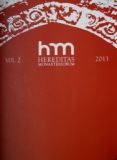Sieć młynów wodnych w dobrach klasztornych na Pomorzu Wschodnim w XIII–XVI w.
Network of watermills in monastic premises in Eastern Pomerania in 13th-16th centuries
Author(s): Rafał KubickiSubject(s): History
Published by: Laboratoire de Recherches sur l'Histoire des Congregations et Ordres Religieux (LARHCOR)
Keywords: watermill; flour-milling; hydropower; Pomerelia; Cistercian Monks; Cistercian Nuns; Norbertine Nuns; Hospitallers of St. John of Jerusalem; Carthusian Friars; Bridgettine Sisters
Summary/Abstract: The study is devoted to the reconstruction of the process of watermills network developing in the estates of separate monasteries in Eastern Pomerania on the background of general milling trends development in this area. Considering this subject, three distinct stages were identified: up to 1308, when the representatives of local dynasty ruled, the years 1309-1454, so the rule of the Teutonic Order, and the period after 1454, in this case limited with the frames of this article to the end of 16th century. The monasteries, thanks to the owned assets and organizational capabilities, have played an important role in the watermills’network developing, especially in the ducal period, up to 1308. Although the monks were not the pioneers in the wastelands management and construction of the first watermills in these areas, they have acted as the main users of existing and newly built mills along with the territorial rulers in the course of time. A certain change has brought the rule of the Teutonic Knights, who ran a consequent economic policy towards other entities, including in particular the monasteries possessing extensive grants from the earlier period. Their actions clearly hindered the further development of the monastic estates, forcing their owners to improve organization of the already held premises. Additionally, on that has imposed the general legal and organizational processes change in the rural economy, also occurring in the goods of great monastic property. Due to that fact each congregation was trying to led self-sufficient economic policy, of which manifestation in the flour milling was imposition of milling coercion on the possessed villages, and conscious construction of own, independent from external conditions, network of milling machines. This policy was continued even after 1454, when the control of the public authority was not so strict... new circumstance at that time was the abolishment of milling regalia, what enabled the rapid development of mill networks in private estates, possibly including the monastic premises. Different factors were subject to change in the network of hydro-powered devices in the territories belonging to the Cistercians of Oliwa. The proximity of Gdańsk, the great urban center, experiencing at that time a massive economic development resulted, that the monastery has become a natural partner for the actions taken by local townspeople. By investing their capital in the construction of more hydro-powered devices on the monastery’s two major waterways, they led to establishment of about 30 devices, in the vast majority – of industrial mills. The case of Oliwa, fundamentally different from other monasteries, was a result of cooperation between two different partners: the monastery –representing the model of a traditional rural economy, and the investors possessing large assets– urban entrepreneurs. In addition to the considerations presented in the article, there is enclosed the monastic mill netwo
Journal: Hereditas Monasteriorum
- Issue Year: 2013
- Issue No: 2
- Page Range: 35-56
- Page Count: 22
- Language: Polish

